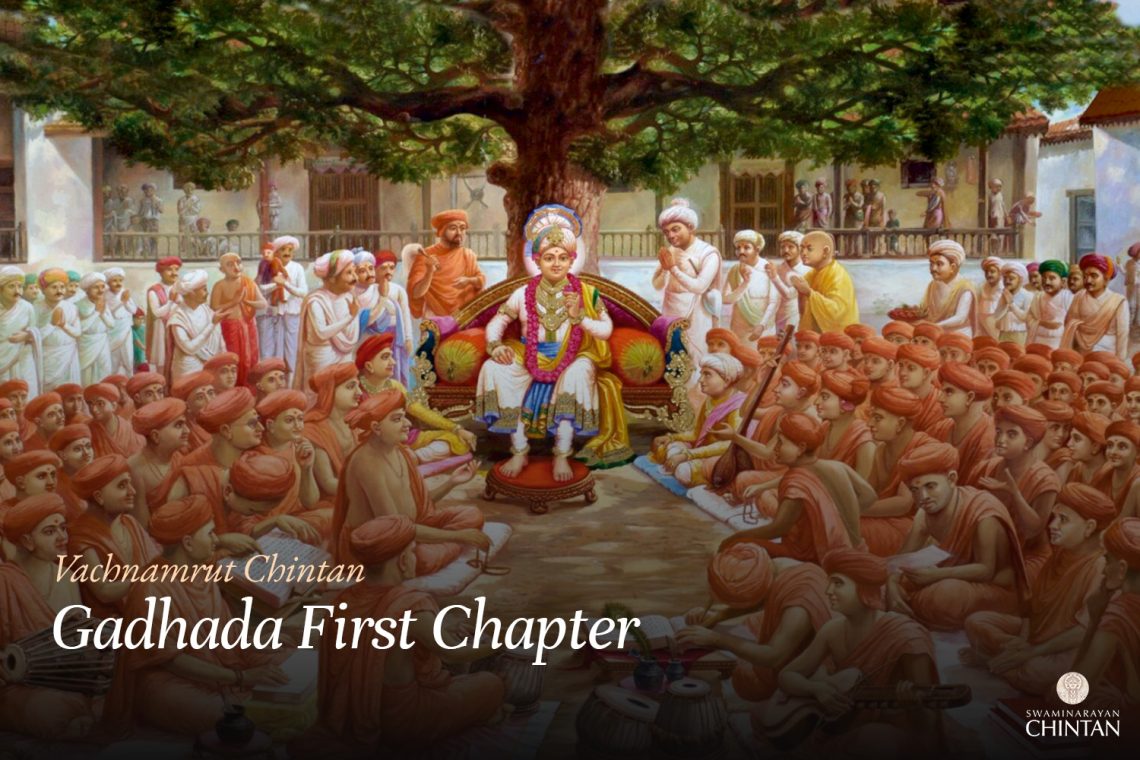Central Insights:
- Lasting impression
- Remedies for removal.
Key Points:
- Materialistic thoughts raised in Rajōguṇ (pleaser seeking attributes of Maya) create a lasting impression in the mind and vāsanā (materialistic desires) get stimulated.
- Kathā–vārtā (Spiritual discourses) should be interpreted internally.
Explanation
The Vachanamrut discusses the impression of desires in the mind and their awakening in the heart. To seat the impression of desires in the mind means that the entrenched desires in the mind arouse corresponding latent desires in the heart. For example, when there is a thought in the mind to see a form or scene, and it awakens a previously existing desire in the heart to see that, it is termed as ‘seating the impression’. There are various ancient desires latent in the heart, but they lie dormant like a snake coiled in a basket. Whenever they get external or internal stimuli, they become active. External stimuli usually come from objects, situations, or individuals that align with the desires, while internal stimuli are usually the thoughts in the mind. Therefore, even when the external object isn’t present, if the mind harbors thoughts related to that desire, it can still activate and become aggressive.
Here, Dinanath Bhatt poses a question to Maharaj, “Oh Maharaj! At times, even with thousands of thoughts passing through, none seem to leave a lasting impression or impact. This means that even if there’s a thought related to a desire, it doesn’t embed itself as a deep-rooted longing. However, occasionally even a fleeting thought can leave a deep impression or longing. What is the reason for this, and how can a devotee of God find a remedy?”
When Tamogun (the attribute of ignorance or inertia) is predominant and a certain thought or impression occurs, it doesn’t leave a mark, as the state is similar to deep sleep (Sushupti). The deep sleep state, characterized by its heaviness or inertia, suppresses the arousal of desires, preventing them from manifesting both internally and externally through the senses.
On the other hand, when Sattvagun (the attribute of purity or illumination) is active, it functions like light. During such times, any arising thought is analyzed, understood, and then dismissed. Hence, it doesn’t leave a lasting mark. In the realm of Sattvagun, discernment is predominant. So, during its influence, any thought or active desire is swiftly negated by this discernment, ensuring that no lingering residue remains.
However, when Rajogun (the attribute of pleasureseeking) is in operation, the thoughts that arise do leave a lasting impression on the mind. This attribute, Rajogun, typically awakens the latent worldly desires in the heart and prompts the formation of intentions. Consequently, there’s an enhanced arousal of these desires, intensifying the pull of indulgence in the mind. This results in a deeper impression or mark on the mind. The Maharaj explains that the reason for these lasting impressions, whether they stay or dissipate, is due to the prevailing attribute. It could be the nature or influence of Rajogun.
Maharaj says, if someone is wise and reflective, they might observe their thoughts during such episodes, and can identify which attribute is dominating at that moment. Yet, every fleeting moment can bring about subtle thoughts, which are often elusive and hard to recognize. For a discerning person like you, only two or three significant materialistic thoughts that arise during the day might be discernible. Maharaj adds that it’s challenging to quickly recognize or experience the swift surge of Rajogun that leads to subtle thoughts.
If someone remains consistently awake and vigilant towards their mind, even the grosser thoughts – those evoking strong desires or momentary deviations from the path of devotion – become noticeable. At such times, one can discern which attribute is currently influencing their heart. However, this discernment doesn’t easily extend to those engrossed in superficial devotion or rituals. Later, such individuals get entangled in the flow of these three attributes, performing every action with a sense of attachment and compulsion. A mere devotee might not be adept at employing this discernment effectively.
Maharaj states that one should keep an eye on the predominant attribute (guna). By ‘keeping an eye’, it is meant that one should oppose it with one’s own spiritual strength and the power of Maharaj, and ponder upon the narratives discussed in the Satsang related to God. The influence of Satsang is so immense that if someone is dominated by Rajogun (attribute associated with passion and desire), then the influence of that guna is diminished. As a result, a state of unwavering focus on the form (murti) of God is achieved. Maharaj says that by pondering upon and internalizing the spiritual narratives of God discussed in the Satsang, the impurities and thoughts stemming from Rajogun are cleared. The excitement of those desires wanes, and the urge for sensual pleasures is pacified.
By the spiritual discourse, Maharaj implies understanding and internalizing its meaning, often referred to as the essence or intent of the scripture or statement in the scriptures. Only by understanding and internalizing this essence can one experience the true taste or nectar. Mere superficial words or examples don’t yield as much benefit. While the superficial words or examples are essential for grasping the concept, greater benefit is derived by contemplating and internalizing the essence. This idea is also discussed in Vachanamrut Kariyani 1. Maharaj states that even a person engrossed in desires like lust, anger, greed, and infatuation, if they listen with faith and love to such spiritual discussions, all their flaws will be dispelled. For instance, a person may find raw chickpeas tasteless but might develop a distaste for rice after consuming sour raw mangoes. Similarly, a person might be very attached to sensual pleasures, but if they listen to such spiritual discussions with faith, they would lose the ability to indulge in those pleasures. No other means, including severe penances or fasting rituals like Chandrayan, can make the mind as dispassionate as listening to these spiritual discussions. These narratives have the power to transform, acting like a tonic, enriching the soul and mind. Hence, believing in these teachings and practicing them with love and devotion is the supreme method to stabilize the mind and cultivate dispassion. There’s no greater means than this to achieve a still and focused mind.
Here too, Maharaj says the same thing, that the influence of Satsang is immense. No other spiritual practice stands equivalent to Satsang. Because other practices, even if diligently followed, cannot clear the influences of attributes like Rajogun as effectively as Satsang can. Therefore, if one wishes to eradicate the influences of Rajogun, one should immerse oneself in Satsang with thought, word, and deed. By doing so, the influence of Rajogun will be eradicated through the power of Satsang.
Glossary
| Antahkaran – Inner faculties The mind, intellect, consciousness, and ego, which help in acquiring spiritual knowledge. |
| Chandrayan Fasting – Ritual Fast A traditional fasting practice involving gradual increase and decrease of food intake, symbolic of self-control and penance. |
| Dispassion – Detachment from Material Desires |
| Nishchay – Firm Faith in Manifested God Believing Manifested God (Bhagwan Swaminarayan) as “My Beloved God” (My Istadev) |
| Pondering – Contemplation |
| Rajoguni Thoughts – Thoughts Dominated by Rajogun |
| Satsang – Holy Fellowship |
| Sushupti – Deep sleep The state of unconsciousness or deep sleep, where the mind is not active, and the individual does not experience desires. |
| Tamogun – Mode of ignorance The quality associated with laziness, delusion, and lack of clarity. |
| Vasana – Latent Materialistic Desires |

